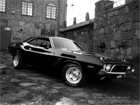 But, as I go down the road, the slight grumble and vibration starts. But not all the time. Tap on the brake's, and it's gone.
But, as I go down the road, the slight grumble and vibration starts. But not all the time. Tap on the brake's, and it's gone.  Thank's, Pat
Thank's, Pat But, as I go down the road, the slight grumble and vibration starts. But not all the time. Tap on the brake's, and it's gone.
But, as I go down the road, the slight grumble and vibration starts. But not all the time. Tap on the brake's, and it's gone.  Thank's, Pat
Thank's, Pat



dave-r wrote:If the pads are just held in place with bent tabs you normally have to give them a tap with a hammer before installation to make them a tight fit.

 Thank's Again , Pat
Thank's Again , Pat
.gif)




Eddie. I only used the word shoe because, my 73 dodge service manual uses the same word.airfuelEddie wrote:Pat, first of all, the pads are nomenclature,(name), for the disc pads. The shoes are for the drum brakes. Your rear brake drum shoes have a primary and secondary shoe. They are different sizes the primary or front shoe contacts the drum first and "pulls" the rear shoe into position thats why they are different thickness and length.
 Back to the Present. Have you seen Disc "Pad's", with different thickness like discribed. Also, beside's the " 73 Dodge Chassis and Service Manual." What's a good book to have? "Chilton", "Haynse", "The Dodge Challenger Service Manual For the Complete Idiot"? Don't know if they make that last one but, had one for my V.W. Bug. That book was Awesome. It even told you when you need to take a brake. No punn intended.
Back to the Present. Have you seen Disc "Pad's", with different thickness like discribed. Also, beside's the " 73 Dodge Chassis and Service Manual." What's a good book to have? "Chilton", "Haynse", "The Dodge Challenger Service Manual For the Complete Idiot"? Don't know if they make that last one but, had one for my V.W. Bug. That book was Awesome. It even told you when you need to take a brake. No punn intended.  Talk to you soon, Pat
Talk to you soon, Pat


 But, that outfit is offering the exact book that I have. I do have the official Dodge service manual for 73 Challenger. I also thought it was funny that they used the word "shoe" pointing at what you, I, and everybody else calls "pad's".
But, that outfit is offering the exact book that I have. I do have the official Dodge service manual for 73 Challenger. I also thought it was funny that they used the word "shoe" pointing at what you, I, and everybody else calls "pad's". 
LOL, I didnt know that Pat! I have the factory 70 manual. Maybe it was written by an AMC guy!patrick wrote:Thank's, Eddie.But, that outfit is offering the exact book that I have. I do have the official Dodge service manual for 73 Challenger. I also thought it was funny that they used the word "shoe" pointing at what you, I, and everybody else calls "pad's".


 I'm gonna play with them a little bit but, if I'm unhappy with the brake's anyway. I'll give it to Mike.
I'm gonna play with them a little bit but, if I'm unhappy with the brake's anyway. I'll give it to Mike.  I'll have him throw in that front brake line while he's at it.
I'll have him throw in that front brake line while he's at it. 

 Either that, or the brake's were seated when, I parked it the other day. I'll turn or replace the rotor's on the next set of pad's. This time, I think I lucked out.
Either that, or the brake's were seated when, I parked it the other day. I'll turn or replace the rotor's on the next set of pad's. This time, I think I lucked out. 




 I wouldn't want you guy's to have to hear me crying about another brake subject.
I wouldn't want you guy's to have to hear me crying about another brake subject. 

I'm glad you caught that Jimi. The same thing happened to a friend of mine. Only, he lost a front wheel. Totally killed his aluminum magnisium mag. Didn't wreck the car though, just the wheel. Shop payed for the wheel and repair's on the front end. How it didn't tear the fender up, I don't know. After that story, I alway's check the torque on the lug nut's. You know, "Ounce of Prevention...."Jimiboy wrote:Nice you got it fixed!
I remember one time when i got my daily a new set of rubber, and had some strange sound and vibrations after, my old dad told me to check the wheelbolts, and i thought it would be the last thing, because i had the job done by the shop... But it was! The guy on the tireshop that mounted the wheels did'nt do the job right, scary!
